Episodes
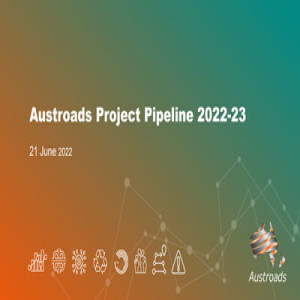
Tuesday Jun 21, 2022
Austroads Project Pipeline 2022-23
Tuesday Jun 21, 2022
Tuesday Jun 21, 2022
This webinar introduces Austroads new projects lined up for the 2022-23 financial year.
The session is most beneficial to consultants who may be interested in tendering for Austroads projects.
Upcoming projects focus on road network resilience, pavement design, movement and place, cycling and micromobility, future freight vehicles, road design, driver licensing, climate change risk assessment, automated and electric vehicle data exchange and provision.
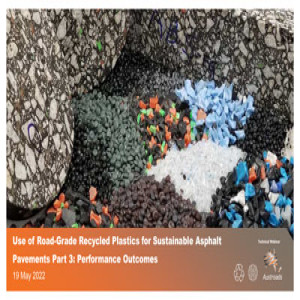
Thursday May 19, 2022
Thursday May 19, 2022
Austroads Project APT6305 Use of Road-grade Recycled Plastics for Sustainable Asphalt Pavements is investigating the use of recycled plastics in asphalt. The project is almost completed with results to date provided in three published reports.
The first report examined the use of road-grade recycled plastics in asphalt pavements and investigated the most suitable types of recycled plastics for incorporation into asphalt.
The second report provided a comprehensive overview of the development of various testing frameworks for the characterisation of road-grade recycled plastic, the incorporation of recycled plastics in bitumen and asphalt and the study of possible emissions and microplastics release.
The third report, the most comprehensive so far, presents the results of the experimental investigation on recycled plastics in asphalt and bitumen by focusing on the asphalt and bitumen properties, microplastics and emissions.
This webinar presents the outcomes of the project to date and covers the results of the multi-faceted (i.e. performance and environmental testing) laboratory investigation on bitumen and asphalt modified with recycled plastics. The session provides details on a potential framework for introducing the use of recycled plastics into current policies and specifications.
Webinar presenters are Andrew Papacostas from Department of Transport Victoria, Associate Professor Filippo Giustozzi from RMIT University and his team, including Dr Marie Enfrin, Yeong Jia Boom, and Dr Dai Lu Xuan.

Thursday Apr 07, 2022
Guide to Project Delivery Parts 2 and 3 Update
Thursday Apr 07, 2022
Thursday Apr 07, 2022
Two parts of the Austroads Guide to Project Delivery – Part 2: Planning and Control and Part 3: Contract Management – have been reviewed and updated to assist road-based infrastructure delivery units of transport agencies to improve efficiencies and reduce costs in the project delivery stage.
In this webinar Colin MacKay, Nigel Powers and Karen Cogo present the updated guides which focus on new industry best practice and techniques that have become available since the Guide to Project Delivery was published in 2014, including lean construction and digital engineering.

Tuesday Mar 29, 2022
Perceptual Countermeasure Treatments to Reduce Crash Risks in Tunnels
Tuesday Mar 29, 2022
Tuesday Mar 29, 2022
Road tunnels are major pieces of infrastructure across the road network, and the number of tunnels is expected to increase in the coming years. Although they are relatively safe, a significant number of crashes occur on the approaches to and within tunnels.
Austroads commissioned the University of New South Wales, Research Centre for Integrated Transport Innovation (rCITI) to investigate and evaluate the application of low-cost perceptual countermeasure (PCM) treatments in road tunnel environments as a means of improving driver speed behaviour, alertness and lane discipline, thereby reducing crash risk. The project involved two key research activities.
Research Activity 1 involved a systematic literature review and stakeholder consultation. Based on the outputs of these activities, three PCM treatments were selected for evaluation in a virtual reality driving simulator: Striped Wall Pattern; Rumble Strips (Edgeline and Centreline); and Pacemaker Lighting.
Research Activity 2 involved an experimental study conducted in the virtual reality driving simulator, located at rCITI. The virtual 3D environment for the driving simulator was based on the cross-sectional layout and alignments of the Sydney Harbour Tunnel. Driving performance data as well as subjective feedback from participants relating to their interaction with the PCM treatments were collected and analysed.
This webinar provides an overview of the two research activities and the key findings deriving from them. It is presented by Professor Michael Regan, Julius Secadiningrat, Dr. Prasannah Prabhakharan, and Mitchell Cunningham.

Tuesday Mar 22, 2022
Tuesday Mar 22, 2022
Austroads has published a report proposing a set of symbols for low and zero emission vehicles (LZEVs) and associated charging or refuelling infrastructure to be used on road signs and for road marking in Australia and New Zealand. The proposal forms a basis for testing and standardisation of the symbols (according to the Australian Standards) and their adoption in the Australian Road Rules and signage manuals.
The background of this work is that with the uptake of low and zero emission vehicles, consistent signage for electric-powered vehicle parking and charging is required. New Zealand has rolled out charging signage nationwide. However, in Australia there are currently no standardised low and zero emission vehicle symbols or signs.
This webinar, presented by Dr Robert Kochhan, Paul Hayes and Dr Clarissa Han, provides an overview of the report and the proposed symbols for the following five categories:
- Electric-powered vehicle
- Electric-powered vehicle being charged
- Charging station for electric-powered vehicles
- Hydrogen fuel-cell powered vehicle and associated refuelling infrastructure
- Access to lanes and roadways designated for electric-powered vehicles and hydrogen fuel-cell powered vehicles.
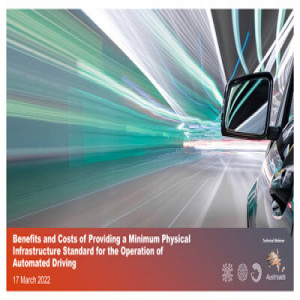
Thursday Mar 17, 2022
Thursday Mar 17, 2022
Physical road infrastructure such as pavement markings and signals may have an important role to play to support the uptake of automated vehicles (AVs). Austroads has recently completed a project to provide road agencies with clear advice on investing in physical infrastructure to support the operation of AVs.
This webinar, presented by Andrew Somers, Simon Xue and Elnaz Irannezhad, provides a detailed overview of the advice that addresses which infrastructure types should be prioritised for investment, as well as the timing and scale for that investment.
The advice has been developed against a backdrop of significant uncertainty around the future of AVs. These uncertainties include the year high-level AVs will become market-ready and the level of reliance of future AVs on physical infrastructures. To inform the development of the advice, the project first undertook an uptake forecast, an infrastructure assessment and economic analysis.
Having accounted for the various uncertainties of future AVs, the project has found the greatest return can be achieved by investments that will:
- support current lower capability AVs
- offer some advantages for human drivers
- be strategically relevant to future higher-level AVs.
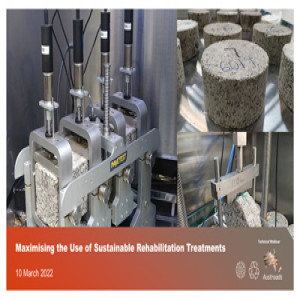
Thursday Mar 10, 2022
Maximising the Use of Sustainable Rehabilitation Treatments
Thursday Mar 10, 2022
Thursday Mar 10, 2022
This webinar, presented by Dr Negin Zhalehjoo, Andrew Papacostas and Dr Didier Bodin, focuses on the outcomes of an Austroads research project “Laboratory Fatigue Characterisation of Foamed Bitumen Stabilised (FBS) Materials”. The objective of this project was to develop a laboratory fatigue relationship to predict the performance of FBS materials to be used for future pavement design of FBS materials. Extensive laboratory experiments were undertaken during the project, including indirect tensile testing and flexural testing on laboratory prepared and cured FBS specimens.
The webinar covers the following key topics:
- A summary of the testing program and procedures to measure and analyse the fatigue life of FBS specimens.
- The results of indirect tensile testing and flexural testing to determine the modulus, strength, and fatigue characteristics of FBS materials.
- The development of a new laboratory fatigue relationship for FBS materials as well as the discussion on the potential link between the fatigue performance of the FBS mixes and the mix properties.
- The comparison between the fatigue life predictions from the Shell asphalt laboratory fatigue relationship against the predictions using the developed presumptive fatigue relationship in this project.
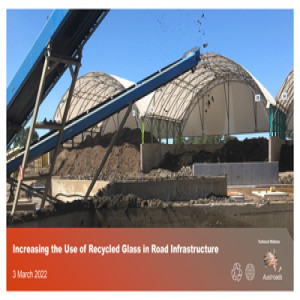
Thursday Mar 03, 2022
Increasing the Use of Recycled Glass in Road Infrastructure
Thursday Mar 03, 2022
Thursday Mar 03, 2022
This webinar, presented by Dr James Grenfell and Dr Didier Bodin, focuses on the development of a specification on the supply of recycled crushed glass sand as part of a project to support increased use of recycled crushed glass (RCG) in road infrastructure. The project covers the use of RCG as a backfill and bedding sand, and within drainage, embankment fill, landscaping, and low risk concrete applications.
The webinar covers the technical basis behind the specification development and discusses the guidelines on how to process RCG.
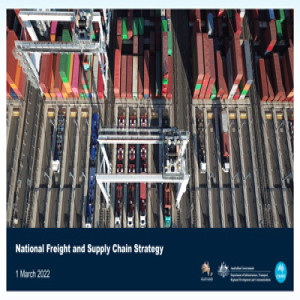
Tuesday Mar 01, 2022
National Freight and Supply Chain Strategy
Tuesday Mar 01, 2022
Tuesday Mar 01, 2022
The National Freight and Supply Chain Strategy sets the agenda for coordinated and well-planned government and industry action to 2040 and beyond, with a national vision for freight systems and supply chains to contribute to a strong and prosperous Australia.
The Strategy commits to action in four key areas:
- Smarter and targeted infrastructure,
- Enable improved supply chain efficiency,
- Better planning, coordination and regulation; and
- Better freight location and performance data.
This webinar, presented by Georgia O’Cianain, Andrew Higgins and Deb Fearns, provides an overview of the following action items under the Strategy:
- National Freight Data Hub, a federated data-sharing network to provide open access to government data, help industry share data together, and collectively answer the big questions about Australia’s freight performance and how we can improve it.
- Supply Chain Benchmarking Dashboard, a web-based data visualisation tool that provides detailed and interactive modelling of Australian transport and logistics supply chains across road and rail. A total of 150 commodities are available with a variety of capabilities including enhanced geographic filtering.
- National Urban Freight Planning Principles, seven high-level principles endorsed by Australian, state and territory governments that provide guidance for land use decision-making across all levels of government to improve planning for freight in Australia’s metropolitan areas.

Thursday Feb 24, 2022
National Walking and Cycling Participation Survey 2021
Thursday Feb 24, 2022
Thursday Feb 24, 2022
Launched in 2011, the National Cycling Participation Survey (NCPS) has been run every two years. Its original aim was to establish a baseline and measure performance against the National Cycling Strategy 2011-2016. Until 2019 the NCPS was managed by Austroads, to maintain a continuous dataset. In 2021, Cycling and Walking Australia and New Zealand (CWANZ) took over the coordination of the survey, adding walking to get a baseline on the level of participation for walking across Australia.
In this webinar, the 2021 National Walking and Cycling Participation Survey (NWCPS) is presented by CWANZ, as coordinators of the 2021 survey, in conjunction with Austroads.
The webinar covers the methodology and provides a brief review of the results. Presenters also talk about how the data is used in different states and some interpretations that can be made.
Speakers include Cameron Munro, CDM Research, Robyn Davies from the Department of Transport and Main Roads, Queensland, and Dr Zarin Salter from the Department of Transport, Western Australia.

